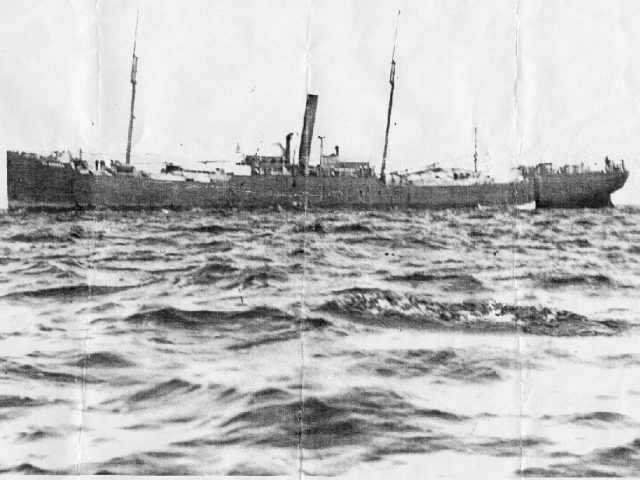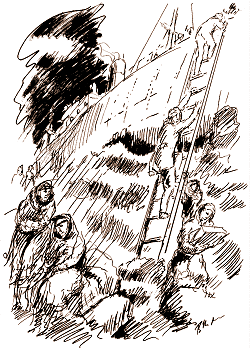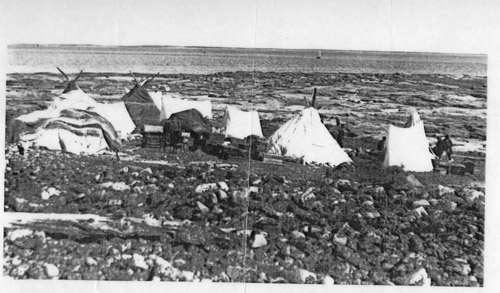
Stumbling out of the forests as if from nowhere came a group of almost fifty people,
survivors of a shipwreck that no one had even heard about. In an age of instantaneous
communication, when the news of London, Vienna and St Petersburg was reported within
hours, a group of castaways could wander for weeks in the north country of Ontario without
anyone knowing of their existence beyond a few isolated Indians and Hudson's Bay Company
officials.
The adventure had begun with a fur trading expedition. Eldorado Freres furriers of Paris, was an old established but expanding concern, which since 1860, had opened stores in London, New York and Montreal. By 1900 they were ready to enter into direct competition with the Hudson's Bay Company for furs at the source. They planned to establish trading posts at the mouths of all the rivers emptying into Hudson Bay, and in preparation, spent 1902 in setting up five posts along the north shore of the St Lawrence and one on the North West River in Labrador; 1903 was to be the year of expansion of no less than five posts in one season.
What followed can only be described as a chapter of accidents. Revillon Freres bought a Norwegian vessel, the Stord, which was loaded at Quebec with trade goods, supplies and prefabricated building material. The Stord sailed in July 1903 under the direction of Revillon's Montreal representative, M d'Aigneux. Agents were sent up the Albany River to hire Eskimo pilots to guide the Stord when it arrived at the south end of Hudson Bay. This precaution proved unnecessary, for the Stord ran aground at Pointe des Monts even before it got out of the Gulf of St Lawrence.
 The directors of Revillon Freres
were now faced with a difficult decision: either abandon their plans for the season and
lose a year's business, or risk getting another boat in and out of Hudson's Bay before ice
closed down navigation. They chose to take the risk, chartering the Eldorado, a vessel of
820 tons, normally used on the run from London to Liverpool. The Eldorado's captain was
William Berry and among the crew, who signed on in Liverpool, was a young able-seaman from
Rosses Point, Thomas Devaney.
The directors of Revillon Freres
were now faced with a difficult decision: either abandon their plans for the season and
lose a year's business, or risk getting another boat in and out of Hudson's Bay before ice
closed down navigation. They chose to take the risk, chartering the Eldorado, a vessel of
820 tons, normally used on the run from London to Liverpool. The Eldorado's captain was
William Berry and among the crew, who signed on in Liverpool, was a young able-seaman from
Rosses Point, Thomas Devaney.
Not daunted by the prospects of abandoning English coastal waters for the rigours of the Hudson Bay route, Captain Berry sailed promptly across the North Atlantic, stopped by the grounded Stord to transfer her cargo, then continued to Quebec City to continue loading.
At Quebec, the Eldorado took on M d'Aigneaux, his wife, daughter, and the child's governess; fourteen French Canadian carpenters, a doctor and four clerks. There were enough provisions to feed those who would be staffing the new posts for three years and, in addition to the contents of the Stord, more sections of prefabricated buildings were loaded as deck cargo. On August 15, the Eldorado set sail with 23 passengers and 24 crew, her destinations Fort George, Rupert's House, Moose Factory, Hannah Bay and Fort Albany. Drawing 16 feet and carrying 1,450 tons of cargo, she was a larger ship than any the Hudson's Bay Company had yet sent into those northerly waters.
The Eldorado successfully navigated the Gulf of St Lawrence and then ran into foul weather. Captain Berry soon abandoned his charts and confessed to having no idea where he was. He apparently got through Hudson Strait by sheer chance, and when the fogs cleared on Hudson Bay the unaccustomed mirages and false horizons made it almost impossible to get accurate bearings. For much of the time, progress was only possible through soundings, and on the night of August 28 the ship cast anchor as the plumb lines indicated 25 feet on one side, four feet on the other. When daylight came. the Eldorado was confronted by an island with sheer cliffs; on the port side a huge rock could be seen breaking over the reefs. There was nothing to do but back out.
On the following day, strong currents took the ship within 200 yards of another rocky island. On August 30, she struck the first reef. The engines were put in reverse, but the ship held firm until the high tide floated her free. Later that night, a glimmer of light some 15 miles away indicated that the expedition had almost reached its first destination, Fort George.
There was no sign of any Eskimo pilots, for they had grown tired of waiting for the Stord and had never received a second message asking them to wait for the Eldorado. The reefs were so numerous that the Captain decided to launch the ship's boat to find a way through. The boat capsized on hitting the water, its engine was ruined, and it had to be hauled back onboard. There was nothing for it, but for the Eldorado to pick its own way through the reefs. Nine miles out of Fort George, the ship struck again, this time at high tide.
George Edward Venables, 21-years-old, was the Eldorado's third engineer. This was his third long voyage, and to make such a break from the London to Liverpool routine, he had decided to keep a diary. He now found that he had much more to record than he had ever bargained for, and was later to recount his adventures at some length: "Everything was done to get the ship off the reef", he wrote, "but when the tide fell, she listed so badly that her decks became almost vertical. Hawsers and winches were used for two days in vainly trying to pull her straight and set her free. her screw, getting fouled somehow, stopped working. So serious were matters now that the Captain insisted that the ladies, child and other passengers should go in boats to Fort George, so as to be safe. I was well as this was done, for on Wednesday, September 2, a terrible storm came on, the ship bumped up and down on the cruel rocks, and finally tore a great hole in her bottom, through which the water rushed in volumes.
"We saved what food we could, and, with some clothes, got away to an island where the doomed vessel was lost. But only some fresh rain-water was found in the hollows of the rocks; nothing else of any use was discoverable."
Donald Gillies, the sole Hudson's Bay Company man at Fort George, visited d'Aigneaux and his dejected companions on September 3. Supplies at Fort George, said Gillies, were quite inadequate to feed the passengers and crew of the Eldorado for more than two days.
Their only chance of survival was to head south before winter set in, to get to Charlton Island where a steamer belonging to the Hudson's Bay Company would shortly be sailing for London with the annual cargo of furs.
Captain Berry was commendably anxious to stay with his ship and salvage what he could; d'Aigneaux would have liked to have something to show for Revillon Freres, and hoped to leave four men behind to staff a rudimentary post for his employers. But Gillies was adamant: time was short, he would help all or none.
There was no real choice in the matter, and the castaways grudgingly accepted the aid of their powerful competitor. d'Aigneaux agreed that all should leave immediately, and Gillies signed a paper confirming that he had asked them to go at once as the only chance of saving their lives.
The castaways set off along the intricate passages to Charlton Island. Gillies provided two Hudson's Bay Company pilots, three lighters and some food. The pilots led the way in two lighters, Captain Berry came next in command of a sailing lighter, then followed the ship's two lifeboats. As George Venables recalled:
"It was a dreadful passage, this one to Charlton Island. We had only some flour, biscuits, a little sugar and fresh water, upon which to rely for our food, and Mr Gillis has provided no small part of this. The weather was just about as bad as it well could be ... We got separated from the pilot's schooner owing to the fogs, and were lost for some time. By firing a gun we had with us, we at last found the others of the party encamped on an island. They had gone there after missing us, on the chance of hearing our signal. So terrible were the storms that more than once we were up to the body in water in the boats, and it seemed as if by no possibility could we escape being swamped and lost. Only by perpetual baling could we keep the craft afloat at all.
Despite everything, all arrived at Charlton Island, but the looked-for steamer had left the day before! As it turned out, this proved to be a rare stroke of luck, for the Lady Head was soon to be wrecked on Gasket Shoals.
George McKenzie, the Hudson's Bay trader at Charlton Island, was as helpful as he could be. He arranged for a few Indians to take the refugees in a small steamer, the Inenew, to the mouth of the Moose river, where, he thought, it would be possible to obtain canoes from Indian trappers and find a way south along the river to safety. With heavy hearts, the castaways moved on. They replenished their supplies a little and were able to get more, at what they considered exorbitant prices, along with canoes and guides at Moose Factory: four sacks of flour for each of five canoes, a hundred pounds of salt, pork, a little tea, some sugar and a few matches. Thus equipped, these voyageurs by necessity began a journey along rivers that challenged even veteran to the limit.
George Venables wrote in his diary:
"We left the Moose River on September 22, and set out on our fearsome journey of what we expected to be 300 miles overland to reach civilisation. We met many bad rapids, and had several narrow escapes whilst the Indians were urging the canoes through them by long poles, as is their custom.
"At length two canoes overturned in one great rapid, and it was all we could do to save their passengers from drowning. We had to go up to our necks in water to reach the capsized canoes, and of course we lost most of the food they contained, which made our plight terrible.
"After this accident it was arranged that we would carry the canoes as much as possible where the waters were too dangerous for their safe passage. Carrying a canoe in such a place is awful work. There was no path by the riverside, of course: often men had to go first and cut away trees, to make way for us. Then, also, the ground was so undulating that only two men could possibly support the canoe, one in front and one behind. The banks were sometimes almost perpendicular and thick with trees. I never saw so much timber in all my life. We camped in flimsy tents at night, but our clothes were always wet through, even before we lay down. Then it was piercingly cold and everything froze on us.
"When we got up each morning, it was invariably to find that the blanket with which each person was provided was a solid piece of ice, as hard as iron, and we had to get it thawed and free as best we could. We endeavoured to bake some of the flour into cakes each night: but as we had no baking powder you can imagine what the result was like. Our rations at best did not run to more than half a cake each per night, and we began to feel very weak and ill from being so underfed and so much exposed. I got the Indians to show me how they made their cakes from flour, as well as they could, and we ate some of those thus made, but it was only like eating dough itself."
After several days of painful progress, the Indian guides announced that the course of the Moose River was so altered that they no longer recognised it, and the current was so strong that they would not attempt to go further. The guides suggested that the group return and follow the Abitibi River. This would make the journey some 200 miles longer, but would be much safer. Once again, there was no choice. Retracing their course and turning down the Abitibi, they found a few more provisions at New Post. There were blueberries to be picked, and the occasional deer and wildfowl supplemented their diet. For ten days the wanderers paddled, poled and portaged. The ladies found their long skirts so much in the way that they converted them into pantaloons. The Indian guides were somewhat difficult to handle, refusing to work on Sundays or in the rain. And so they continued until they reached the beginning of lake Abitibi. There the guides stated that since they had no idea what lay ahead, they were going home.
The castaways continued alone, but not for long. They met a solitary Indian later the same day, and he agreed to guide them to safety. He was returning from a hunting expedition, and said he could find the way by the sun and stars to Douglas Farm on Lac des Quinze, a lumber camp, which was the northernmost reach of civilisation. He took his place in the first canoe and told the others to follow close behind. Linked to stern they proceeded through the convolutions of lake Abitibi in the fog and rain.
One morning, just before breaking camp, the travellers met an English Army major out big game hunting. he was unable to offer much in the way of material comfort, but he was able to tell them who had won the America Cup Race the month before. Douglas Farm came into sight on October 15, and the reluctant voyageurs were able to feast on potatoes and bread that night.
The lumber camp was little better equipped to feed and shelter such a large number of people, than the remote Hudson's Bay Company's posts had been, and the party pushed on overland to the banks of the Ottawa River. The only track was a logging road, thigh deep in mud, at that time of year. It was at this stage that they suffered their only casualties; two men were left by the wayside and were picked up later in reasonably good health.
Arrived on the banks of the Ottawa, the castaways took a small boat to New Liskeard, where the news of their adventures was recorded by the Globe's correspondent. "It was a tale", he wrote,"as remarkable in its ways as any that has come out of the North in recent years". With some understandable confusion he wrote of portaging the Eldorado's lifeboat around innumerable rapids through terrain "as unknown to the party as if it had been in the heart of Africa."
The wreck of the Eldorado put Rivillon's plans back by three years. Rather naturally, they made a point of blaming the Hudson's Bay Company for the poor quality of charts available for northern waters, and insisted that their expedition had received in help in its distress.
Captain Berry too was: "Not very complementary in his criticisms of the sailing charts", as a Montreal reporter tactfully put it. Certainly Berry would have to have a good story ready; he was scheduled to meet the shareholders in Montreal a week after his return.
Wreck in Far North from The Gazette, Montreal, 1903
Tale of Shipwreck in the Far North from The Montreal Daily Star, Monday, October 19, 1903